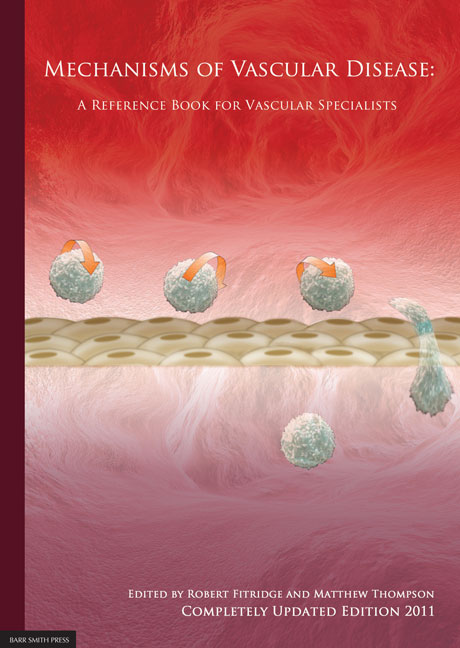Book contents
- Frontmatter
- Contents
- List of Contributors
- Detailed Contents
- Acknowledgements
- Abbreviation List
- 1 Endothelium
- 2 Vascular smooth muscle structure and function
- 3 Atherosclerosis
- 4 Mechanisms of plaque rupture
- 5 Current and emerging therapies in atheroprotection
- 6 Molecular approaches to revascularisation in peripheral vascular disease
- 7 Biology of restenosis and targets for intervention
- 8 Vascular arterial haemodynamics
- 9 Physiological Haemostasis
- 10 Hypercoagulable States
- 11 Platelets in the pathogenesis of vascular disease and their role as a therapeutic target
- 12 Pathogenesis of aortic aneurysms
- 13 Pharmacological treatment of aneurysms
- 14 Pathophysiology of Aortic dissection and connective tissue disorders
- 15 Biomarkers in vascular disease
- 16 Pathophysiology and principles of management of vasculitis and Raynaud's phenomenon
- 17 SIRS, sepsis and multiorgan failure
- 18 Pathophysiology of reperfusion injury
- 19 Compartment syndromes
- 20 Pathophysiology of pain
- 21 Post-amputation pain
- 22 Treatment of neuropathic pain
- 23 Principles of wound healing
- 24 Pathophysiology and principles of varicose veins
- 25 Chronic venous insufficiency and leg ulceration: Principles and vascular biology
- 26 Pathophysiology and principles of management of the diabetic foot
- 27 Lymphoedema – Principles, genetics and pathophysiology
- 28 Graft materials past and future
- 29 Pathophysiology of vascular graft infections
- Index
27 - Lymphoedema – Principles, genetics and pathophysiology
Published online by Cambridge University Press: 05 June 2012
- Frontmatter
- Contents
- List of Contributors
- Detailed Contents
- Acknowledgements
- Abbreviation List
- 1 Endothelium
- 2 Vascular smooth muscle structure and function
- 3 Atherosclerosis
- 4 Mechanisms of plaque rupture
- 5 Current and emerging therapies in atheroprotection
- 6 Molecular approaches to revascularisation in peripheral vascular disease
- 7 Biology of restenosis and targets for intervention
- 8 Vascular arterial haemodynamics
- 9 Physiological Haemostasis
- 10 Hypercoagulable States
- 11 Platelets in the pathogenesis of vascular disease and their role as a therapeutic target
- 12 Pathogenesis of aortic aneurysms
- 13 Pharmacological treatment of aneurysms
- 14 Pathophysiology of Aortic dissection and connective tissue disorders
- 15 Biomarkers in vascular disease
- 16 Pathophysiology and principles of management of vasculitis and Raynaud's phenomenon
- 17 SIRS, sepsis and multiorgan failure
- 18 Pathophysiology of reperfusion injury
- 19 Compartment syndromes
- 20 Pathophysiology of pain
- 21 Post-amputation pain
- 22 Treatment of neuropathic pain
- 23 Principles of wound healing
- 24 Pathophysiology and principles of varicose veins
- 25 Chronic venous insufficiency and leg ulceration: Principles and vascular biology
- 26 Pathophysiology and principles of management of the diabetic foot
- 27 Lymphoedema – Principles, genetics and pathophysiology
- 28 Graft materials past and future
- 29 Pathophysiology of vascular graft infections
- Index
Summary
INTRODUCTION
The lymphatic circulation consists of a network of blind-ended capillaries lined with endothelial cells that drain into larger vascular trunks and eventually empty into the blood circulation. It is otherwise totally separate from the blood circulation although lymphatics are often anatomically related to arteries and veins. Lymphatic vessels are found in nearly all tissues and have several important functions including transportation of fluids, plasma macromolecules, and cells back to the blood circulation. The lymphatics also form a major transport route for lipids absorbed from the intestinal tract, and are a critical component of the immune system transporting leucocytes and antigens from the tissues to the lymphoid organs.
Lymphoedema is an accumulation of tissue fluid in the interstitial space as a result of failure of the lymphatic circulation. This can be severe and disfiguring. Defects in the lymphatic system can be primary or acquired. Lymphoedema most frequently affects the legs (80%) although can present as swelling of the arms, face or external genit alia. (Figure 27.1)
CLASSIFICATION OF LYMPHOEDEMA
The diagnosis of lymphoedema should be reserved for those patients in whom a secondary cause of oedematous swelling has been excluded. (Table 27.1). Chronic venous disease is a common cause of unilateral swelling and there are often other characteristic skin changes. Sub-clinical lymphoedema sometimes becomes apparent when other conditions such as venous hypertension cause an increase in fluid and protein forced into the interstitial space that overwhelms a poorly functioning lymphatic system.
- Type
- Chapter
- Information
- Mechanisms of Vascular DiseaseA Reference Book for Vascular Specialists, pp. 497 - 510Publisher: The University of Adelaide PressPrint publication year: 2011
- 1
- Cited by



